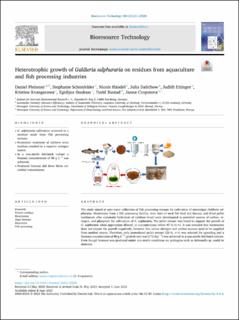| dc.contributor.author | Pleissner, Daniel | |
| dc.contributor.author | Schönfelder, Stephanie | |
| dc.contributor.author | Händel, Nicole | |
| dc.contributor.author | Dalichow, Julia | |
| dc.contributor.author | Ettinger, Judith | |
| dc.contributor.author | Kvangarsnes, Kristine | |
| dc.contributor.author | Dauksas, Egidijus | |
| dc.contributor.author | Rustad, Turid | |
| dc.contributor.author | Cropotova, Janna | |
| dc.date.accessioned | 2023-08-14T11:10:20Z | |
| dc.date.available | 2023-08-14T11:10:20Z | |
| dc.date.created | 2023-06-08T12:31:32Z | |
| dc.date.issued | 2023 | |
| dc.identifier.issn | 0960-8524 | |
| dc.identifier.uri | https://hdl.handle.net/11250/3083815 | |
| dc.description.abstract | The study aimed at zero-waste utilization of fish processing streams for cultivation of microalgae Galdieria sulphuraria. Wastewater from a fish processing facility, slam (mix of used fish feed and faeces), and dried pellet (sediments after enzymatic hydrolysis of rainbow trout) were investigated as potential sources of carbon, nitrogen, and phosphate for cultivation of G. sulphuraria. The pellet extract was found to support the growth of G. sulphuraria when appropriate diluted, at concentrations below 40 % (v/v). It was revealed that wastewater does not impact the growth negatively, however free amino nitrogen and carbon sources need to be supplied from another source. Therefore, only proteolyzed pellet extract (20 %, v/v) was selected for upscaling and a biomass concentration of 80 g L−1 (growth rate was 0.72 day−1) was achieved in a non-sterile fed-batch culture. Even though biomass was produced under non-sterile conditions no pathogens such as Salmonella sp. could be detected. | en_US |
| dc.language.iso | eng | en_US |
| dc.publisher | Elsevier | en_US |
| dc.rights | Navngivelse 4.0 Internasjonal | * |
| dc.rights.uri | http://creativecommons.org/licenses/by/4.0/deed.no | * |
| dc.title | Heterotrophic growth of Galdieria sulphuraria on residues from aquaculture and fish processing industries | en_US |
| dc.title.alternative | Heterotrophic growth of Galdieria sulphuraria on residues from aquaculture and fish processing industries | en_US |
| dc.type | Peer reviewed | en_US |
| dc.type | Journal article | en_US |
| dc.description.version | publishedVersion | en_US |
| dc.source.journal | Bioresource Technology | en_US |
| dc.identifier.doi | https://doi.org/10.1016/j.biortech.2023.129281 | |
| dc.identifier.cristin | 2153026 | |
| cristin.ispublished | true | |
| cristin.fulltext | preprint | |
| cristin.qualitycode | 1 | |

